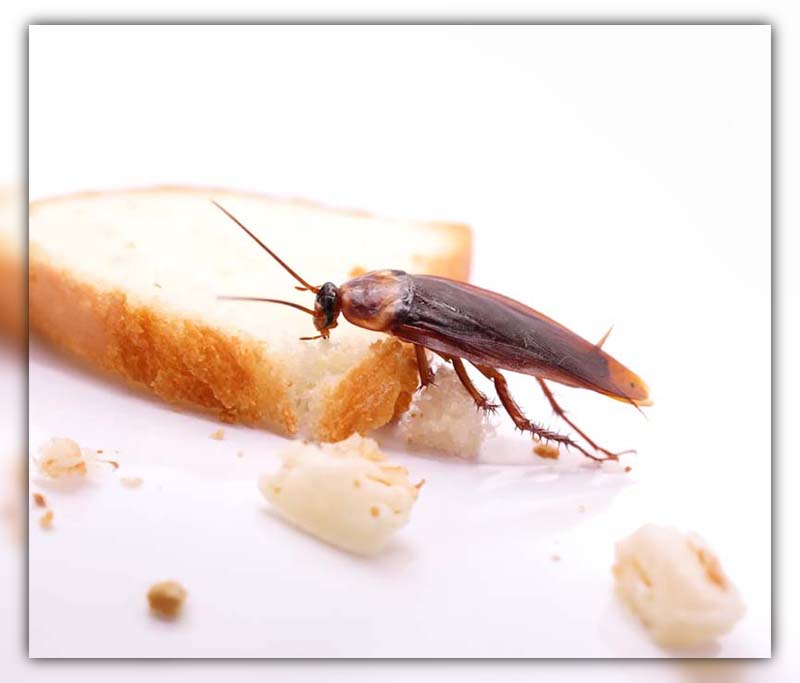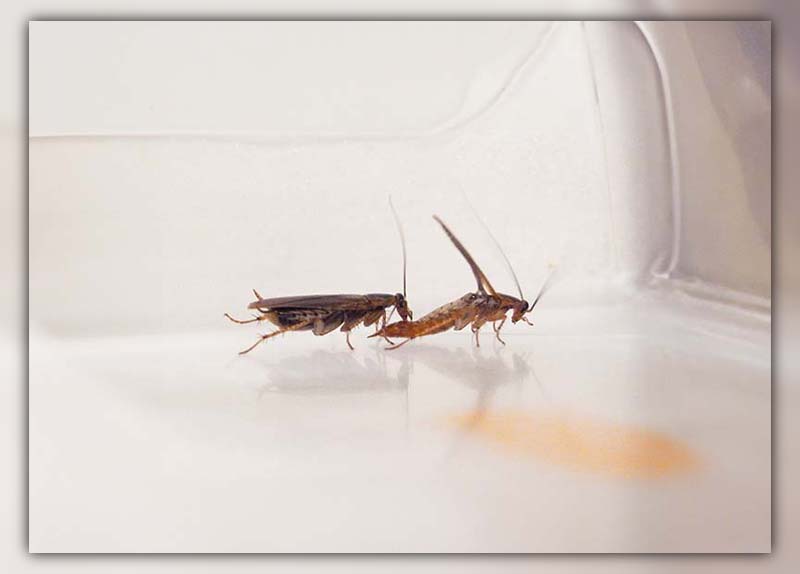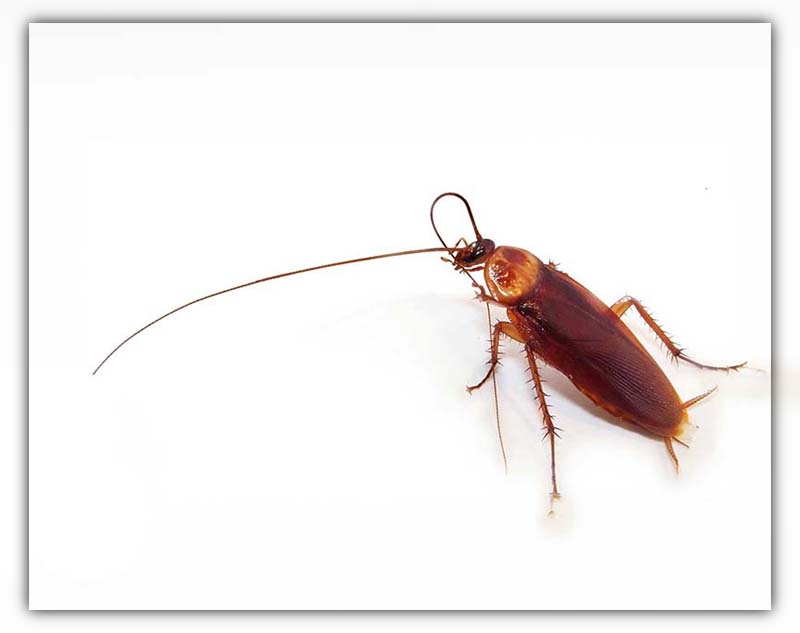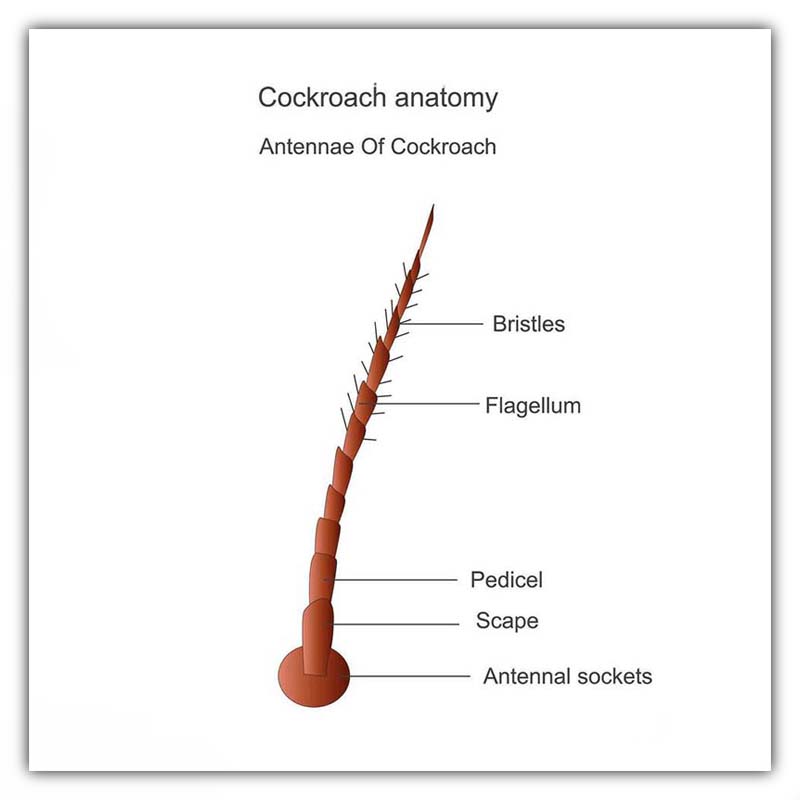The nimble navigation of roach with long antennae through intricate spaces and their uncanny knack for sensing danger and food sources isn’t accidental.
It’s all attributed to their antennae.
We explore the captivating realm of the cockroach antennae, unveiling its essential role in their survival and offering a fresh perspective on these ubiquitous inhabitants.
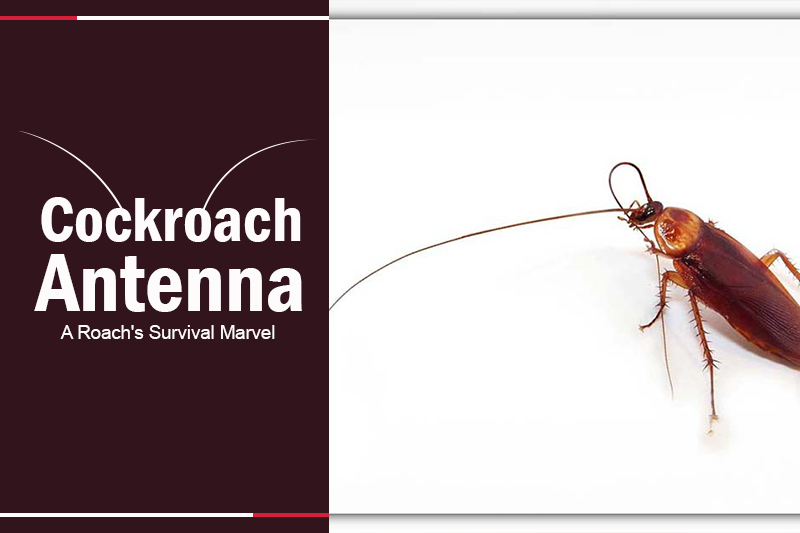
The Functions of Cockroach Antennae
Cockroach with long antennae possess limited eyesight and primarily depend on their antennae to interact with their environment, helping them navigate various challenges and fulfill their primary instinctual tasks.
Locating Food
Cockroaches might not boast excellent eyesight, but their antennae more than compensate.
Rich with olfactory receptors, these sensitive structures can bind to airborne or surface-bound molecules.
As cockroaches sweep their antennae back and forth, they detect particles that hint at the presence of food.
Following these molecular breadcrumbs, roaches can locate delicious remnants, decaying matter, or other consumables.
As the aroma strengthens, indicating proximity to a food source, signals travel from the antennae to the brain, guiding the roach without antenna to its next meal.
>> Read more: What happens if you eat food a roach crawled on?
Mating
When it’s time to find a mate, cockroaches turn to their antennae’s power of scent detection.
By releasing specific odors in their excrement, they communicate their readiness to breed.
While humans might not notice these scents, to a cockroach, they’re the equivalent of a romantic invitation.
If distanced from potential partners, their antennae serve as compasses, steering them towards nesting sites or a specific mate.
This antennal communication even influences their hormonal responses, preparing their bodies for reproduction.
Interestingly, without these appendages, roaches face challenges in distinguishing between genders, often hindering their mating success.
>> Read more: What does roach droppings look like? The Surprising Realit!
Navigation
Roach antennas aren’t blind, but their long-distance vision isn’t sharp.
Up close, they can see in the dark and almost all around them. But just using their eyes might make them miss things in their way.
So, their feelers act like extra eyes, helping them understand their surroundings better.
These feelers of a cockroach can sense changes in the air and feel vibrations. This lets them:
- Spot things from far away
- Know when dangers or other animals come closer
- Notice when things move or fall
For things close to them, roaches use their feelers even more. They wiggle these feelers and tap them on the ground to:
- Check out nearby things
- Find out if the ground changes
Intriguingly they can even use these feelers to know where the sun is.
Even though roaches mostly come out at night, they sometimes appear in the day.
Their feelers guide them when they move from one place to another.
Avoiding Predators
Cockroaches are often the hunted, not the hunters, since they don’t have ways to defend themselves aggressively.
Their best strategy is to detect threats early on and run away.
They rely heavily on their antennae to warn them of danger.
These feelers don’t just pick up the scent of predators; they can also sense shifts in the air to determine which way the threat is coming from.
Plus, they feel vibrations.
Roaches can sense the nearing of a predator both by sound and touch.
They can even gauge how fast it’s moving towards them.
As a result, creatures that hunt cockroaches often need to be faster or sneak up on them.
Just a little movement can signal a roach that it’s time to make a quick escape.
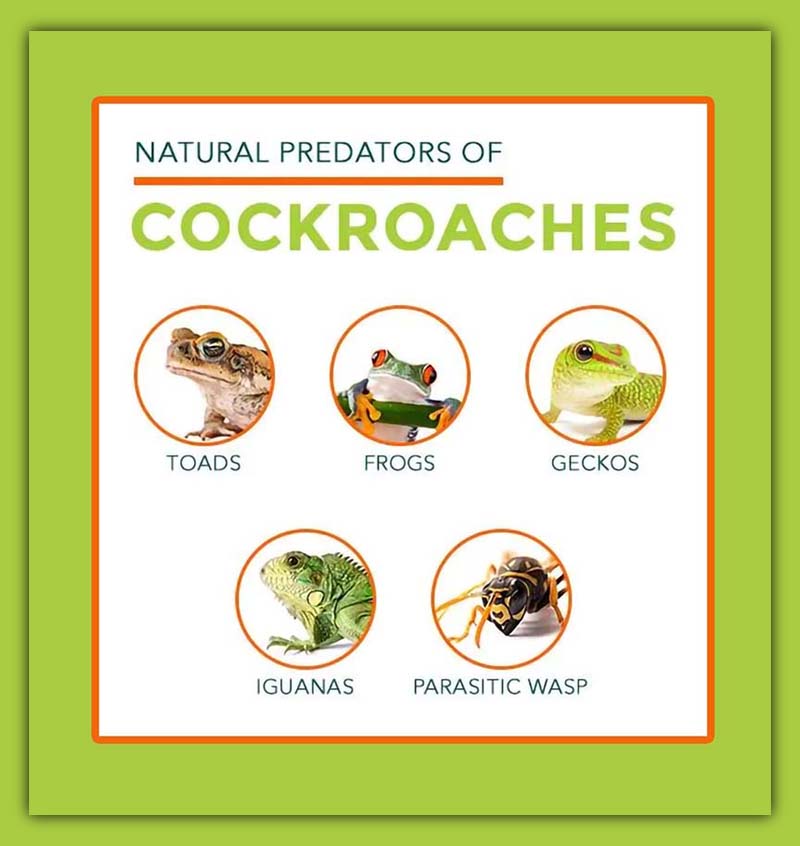
Sensing Weather
Cockroaches use their antennae to detect weather changes.
They have special cells called thermoreceptors that can sense air temperature and even the amount of moisture in the air.
But that’s not all. These insects can actually forecast the weather.
In their antennal joints, they have something called proprioceptors, which can pick up shifts in barometric pressure.
This alerts them if a storm is on the horizon.
Big storms with heavy rain, strong winds, and falling objects can be deadly for these small creatures.
Without early warning, they could drown, get carried away, or be injured by debris during such weather.
So, to protect themselves, cockroaches rely on their antennae to know when to head for safety.
In Santa Barbara County, it’s been observed that cockroaches can detect storms coming about 4 hours ahead.
When a big rain is about to come, you might see a swarm of cockroaches racing across streets or through cities looking for a safe spot.
>> Read more: Cockroaches Play Dead: The Truth Behind Playing Dead.
Purpose of Cockroach Antennae
Cockroaches, despite being disliked, have evolved with remarkable survival tools, especially their antennae, which help them adapt and navigate their surroundings.
- Sustaining Life: Their antennae serve as sophisticated sensors in scavenger hunt, ensuring they don’t go hungry in their unpredictable habitats.
- Propagation: By detecting specific pheromones, these antennae facilitate mating interactions. Without this mechanism, the continuity of the cockroach lineage would be in jeopardy.
- Self-Preservation: Roaches, despite their infamous tenacity, are often on the menu for many creatures like birds, mammals, and other insects, cockroaches depend on their antennae to sense danger, giving them a head start to scurry away to safety.
However, if a cockroach were to lose even one of its antennae, it would face a host of challenges. Such an unfortunate roach would likely become:
- Disoriented, struggling to navigate its environment.
- Easily misplaced, wandering aimlessly.
- Clumsy, bumping into objects without proper spatial awareness.
- More susceptible to lurking predators.
- Incapable of locating vital food sources.
- Hindered in its ability to find a mate and reproduce.
- In controlled environments, researchers have observed a pronounced behavioral shift in cockroaches bereft of their antennae. They increased aggression and exhibited erratic behaviors, such as recklessly colliding with objects around them.
Can Cockroaches Regrow Antennae?
Yes. One of the cockroach’s marvels lies in its capacity to regenerate lost body parts.
If a cockroach loses a portion of its antenna, it possesses the potential to regrow up to 30% of the lost section during its subsequent molt.
While full regeneration might necessitate several molting cycles, once the process is complete, the roach reclaims full functionality of its antenna and resumes its regular activities.
Should a cockroach find itself with an injured or missing antenna, it doesn’t merely give up.
Instead, it exhibits behavioral modifications to cope with its impairment.
Such a roach tends to stay closer to walls, using them as tactile guides, and is less likely to stray far from its home or food reserves.
An intriguing revelation from the journal “Zoological Science” which is published by the Zoological Society of Japan and is devoted to the publication of original articles, reviews, essays, and editorials covering the broad and increasingly interdisciplinary field of zoology, suggests that even if a cockroach is deprived of its sight, its antennae still provide ample navigational assistance.
In an eye-opening study, researchers explored the roach’s adaptability by attaching a tiny metal plate to one of its antennae. This additional weight hindered the insect’s antennal movement, allowing scientists to monitor:
- The frequency of antennal motion
- The muscles impacted
- The insect’s response to this imposed impediment
Subsequently, a vital mechanosensory organ, known as the scapular hair plate, was removed. This alteration caused the cockroach’s resting antenna to shift about 20 degrees outward.
But in true cockroach fashion, it wasn’t long before the insect adapted.
It modified its movement patterns, compensating for both involuntary and deliberate actions.
To put it succinctly, while the roach originally relied on its scapular hair plate for both intentional and reflexive movements, it quickly adjusted to the situation, biding its time until full antennal regeneration.
Types of Cockroach Antennae
Cockroaches, often perceived as unwanted pests, have fascinating anatomical features. A particularly notable part of their anatomy is their antennae, which serve as complex sensory organs.
Cockroaches sport what’s known as filiform antennae. These are characterized by their:
- Slender shape
- Extended length
- Consistent diameter across its length
Among the myriad antenna designs in the insect realm, the filiform type is viewed as rather rudimentary. Think of it as a segmented thread, split into three primary sections:
- Flagellum
- Pedicel
- Scape
These segments are seamlessly interconnected with pliable joints, permitting fluid movement without the risk of fracturing. At the antennae’s base, specialized muscles enable cockroaches to perform a variety of movements such as twitching or lifting.
Cockroach antennae are rich in sensory receptors, mainly categorized as proprioceptors and exteroceptors. These are essentially internal and external sensors. The key mechanoreceptors found in a roach’s antennae encompass:
- Campaniform sensillum
- Hair sensillum
- Chordotonal sensillum
Flagellum
The flagellum stands out as the lengthiest segment and is densely populated with sensillae – tiny hair-like structures responsible for detecting:
- Chemicals
- Humidity levels
- Scents
- Temperature variations
- Atmospheric pressure shifts
Each sensillum is intricately linked to the roach’s nervous system, channeling signals to designated regions in its brain. For instance:
- Humidity data is relayed to specific neurons.
- Information about temperature is passed through the olfactory sensillae, leading to the antennal lobe.
- Both chemosensory and mechanosensory sensillae transmit data to structures like the deutocerebrum and subesophageal ganglion.
Pedicel And Scape
The pedicel and scape play crucial roles in gathering and transmitting additional sensory details to the roach’s brain.
This allows them to analyze external motions, gauge their own position, and monitor the state of their antennae.
When a cockroach nears an object, its flagellum discerns temperature and chemical composition.
Concurrently, the pedicel evaluates the object’s direction and solidity.
This intricate process is largely credited to the campaniform sensilla and external hair on the cockroach’s antennae, with the chordotonal sensillum situated directly within the pedicel.
Antennal Movement in Cockroaches
When observing a cockroach meticulously moving its antennae up and down, it’s not just a random act. This rhythmic motion is the roach’s way of probing its surroundings. Through this seemingly simple action, cockroaches can:
- Determine their next path.
- Foresee what awaits them, be it nourishment or a lurking predator.
- Gauge the proximity of nearby objects.
Powering these intricate antennae movements is a remarkable ensemble of five distinct muscles situated within the antenna and extending across the roach’s head to the scape of the antennae. Here’s a brief on each:
- Adductor Muscles: Tasked with medially rotating the scape on the cockroach’s head.
- Abductor Muscles: They manage the lateral rotations of the scape.
- Levator Muscles: Their role? To elevate the scape vertically.
- Depressor Muscles: These are vital for maneuvering the pedicel part of the antennae.
- Muscles at the Scape’s Ends: While they’re often associated with depressor muscles, these tiny yet essential muscles grant the roach added dexterity over the pedicel section.
What’s even more fascinating is that the coordinated effort of these five muscles is orchestrated by merely 2-3 neurons, known as excitatory motor neurons.
These neurons are the messengers that relay information to and from the brain stem.
If managing antennae movement sounds intricate, that’s because it genuinely is.
Cockroaches possess an elaborate interplay of muscles, joints, nerves, and neurons, enabling them to adeptly traverse their environment.
Cockroach Antenna Tugging
When you observe a cockroach delicately pulling at its antennae, it’s not a random action but a meticulous cleaning ritual.
These antennae play a pivotal role in sensing odors and examining the environment.
When caked with substances like dirt, food particles, waste, or other debris, their efficiency diminishes.
Contrary to the common perception of roaches as unclean creatures, they are, in fact, diligent groomers.
A cockroach may attentively clean its antennae multiple times throughout the day.
This cleaning process can involve drawing the antennae through its mouth or skillfully using its legs to pull on the fine strands—reminiscent of the art of spinning yarn.
In essence, while roaches can get by without their antennae, these appendages are integral tools in their day-to-day life, assisting them in tasks like seeing, moving, feeding, and mating.
Conclusion
In essence, the cockroach antenna is a marvel of nature, playing a crucial role in these creatures navigation, survival, and daily life.
It’s a testament to the intricate design and adaptability of even the smallest beings in our world.
To delve deeper into the captivating realm of pests and their peculiarities, don’t hesitate to explore more enlightening blogs from Pestweek.

Calina Mabel has over 15 years of experience in the field of journalism and communications. Currently, Calina Mabel is the Content Writer for categories such as Cockroach, Ants, Bed Bugs, Mosquito, Rodent, Termite, and Flies on Pestweek.com. She aims to build content for these categories with a focus on providing valuable and accessible information to readers, in order to create the world’s largest knowledge community about Pests.
All content written by Calina Mabel has been reviewed by Emily Carter.



